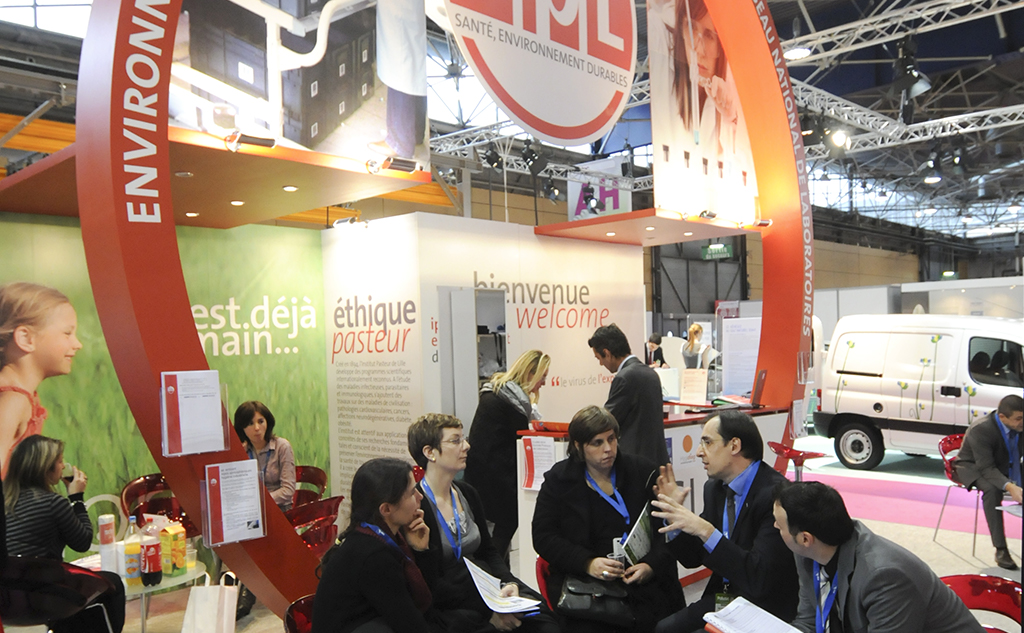Environmental health: a catalyst at Pollutec
Water, air, food and the soil, but also workplaces, are all some of the many sources of human exposure to chemical and microbiological contaminants and physical agents, of which the effects on human health are becoming increasingly evident. As of 2004, Pollutec put forward Environmental Health as a major theme, which involved a European congress on the challenges and consequences for industry and towns, a hospital and sustainable development village since 2013 backed by C2DS and IHF, and numerous interventions on the Environment, Risks and Health Forum lead by the Inéris and the IRSN, the CSTB and the Ademe, and televised debates with the magazine ERS. This focus on a transversal concern, with, for the time being, little media coverage made it possible to not only inform but also to unite efforts and provide visibility for new stakeholders and innovative solutions. As a result, these concerns are today widely disseminated and integrated in the show, at the very heart of the themes of air, water, soil or waste.
A village for spreading the word
“After being welcomed from 2001 by our regional Ile-de-France stand, an environmental health village was essential for us. Without it, we would have been lost at the show”, confides Jean-Emmanuel Gilbert, at the time founding director of the company Vigicell*, spin-off of the CNRS, specialised in the analysis of cellular stress signal information, indicator of dangerousness. “It was necessary to shatter the myth. We were so convinced that the dose made the poison that extensive explanatory work was necessary”. Since, things have changed considerably. The subject is a lot more present and terms like micropollutant, endocrine disruptors, toxicityand genotoxicity are better understood. “However, to arrive at this level of development on the topic of environmental health, it was necessary to spread the word, to which Pollutec effectively contributed”.
Increasingly rapid and cutting-edge diagnostic tools
Avec la montée de la problématique Santé-Environnement, la disponibilité d’une métrologie portable, rapide et robuste est devenue cruciale. Un besoin largement adressé par l’émergence de solutions métrologiques en rupture. Dans l’eau, les premiers outils présentés pour le suivi des risques sanitaires apparaissent entre 2001 et 2005 (cf. Vigicell, Mêtis Biotechnologies, Genesystem, Aquatools, Anhydre…). Suit un logiciel d’évaluation des risques microbiologiques, lancé en 2009 par l’Astee. En 2010, on découvre même un test rapide de détection rapide de Bisphénol A (Vidia) et en 2012, c’est au tour des têtards fluorescents de Watchfrog, indicateurs de perturbation endocrinienne, de faire l’actualité. Bien sûr, cette tendance en métrologie s’illustre aussi dans le monde de l’air. La startup normande Aykow lance par exemple à Pollutec 2010 un détecteur temps réel de radon(responsable de 10 % des cancers des poumons). Le CSTB cible quant à lui en 2014 le suivi de la contamination fongique dans les bâtiments. Mais l’innovation « historique » dans ce secteur est sans doute celle de Cairpol, alors jeune startup (aujourd’hui au sein d’Envea group), qui présente en 2006 et 2007 le prototype puis le premier modèle d’une montre de suivi individuel en temps réel des pics de pollution (ozone et NO2) permettant à son porteur d’adapter son activité physique. Une technologie miniature aujourd’hui valorisée au sein de petits capteurs connectés servant à mailler un territoire pour en suivre la qualité de l’air.
* 3rd EEP Awards 2005
INNOVATIONS OF 2018: SOLUTIONS FOR DETECTING LEGIONNAIRES’ DISEASE IN RECORD TIME
In 2018, a young company, C4Hydro, presented its solutions at the Pollutec trade show for detecting and counting, within 48 hours, the bacteria that causes Legionnaire’s disease, Legionella pneumophila.
After several years of decline, this infectious disease is today somewhat on the rise again. In Europe, the number of reported cases of Legionnaires’ disease reached 9,238 in 2017. And two out of three of these cases were declared in just four countries – Italy, France, Spain and Germany.
On the basis of an innovation from the CNRS protected by six patent families, C4Hydro has developed and marketed fast, simple methods for the precise detection and monitoring of Legionella pneumophilaconcentrations in water. Based on culturing this pathogenic bacterium, these solutions are the only ones capable of assessing the effective risk in record time – 48 hours instead of over 10 days.
The goal is to react immediately in case of contamination, but also to reduce operating costs for preventing the proliferation of this deadly bacterium found in modern hot water supply systems and in cooling circuits in certain industries (plastics, ironworks, metallurgy, etc.).
These turnkey solutions can be used in the field as well as in laboratories, making it possible to obtain fast, reliable results for customers who want fast control over the risk of Legionnaire’s disease connected with their facilities.




